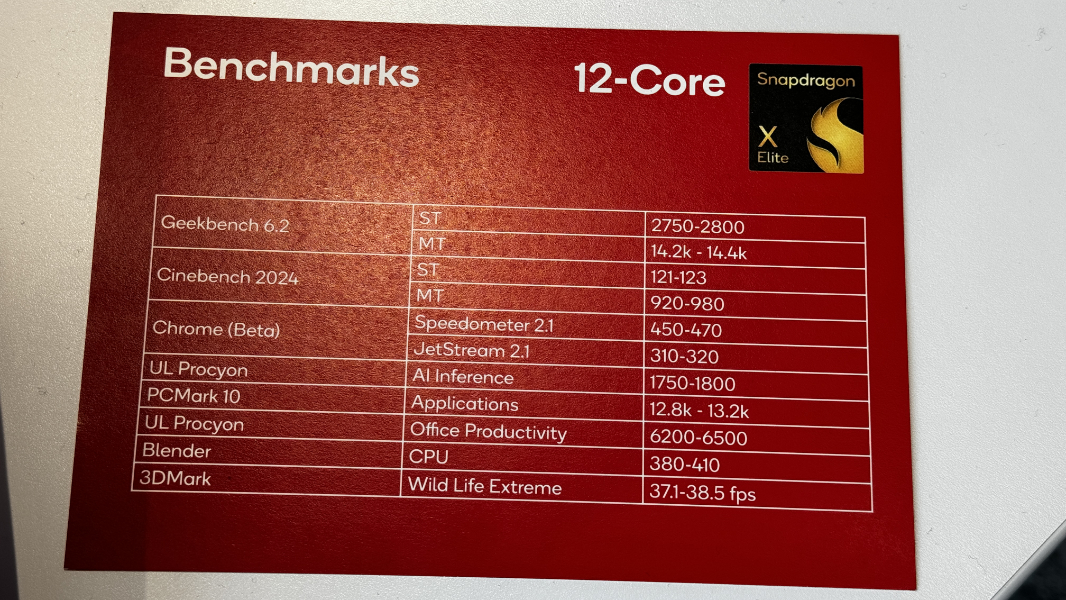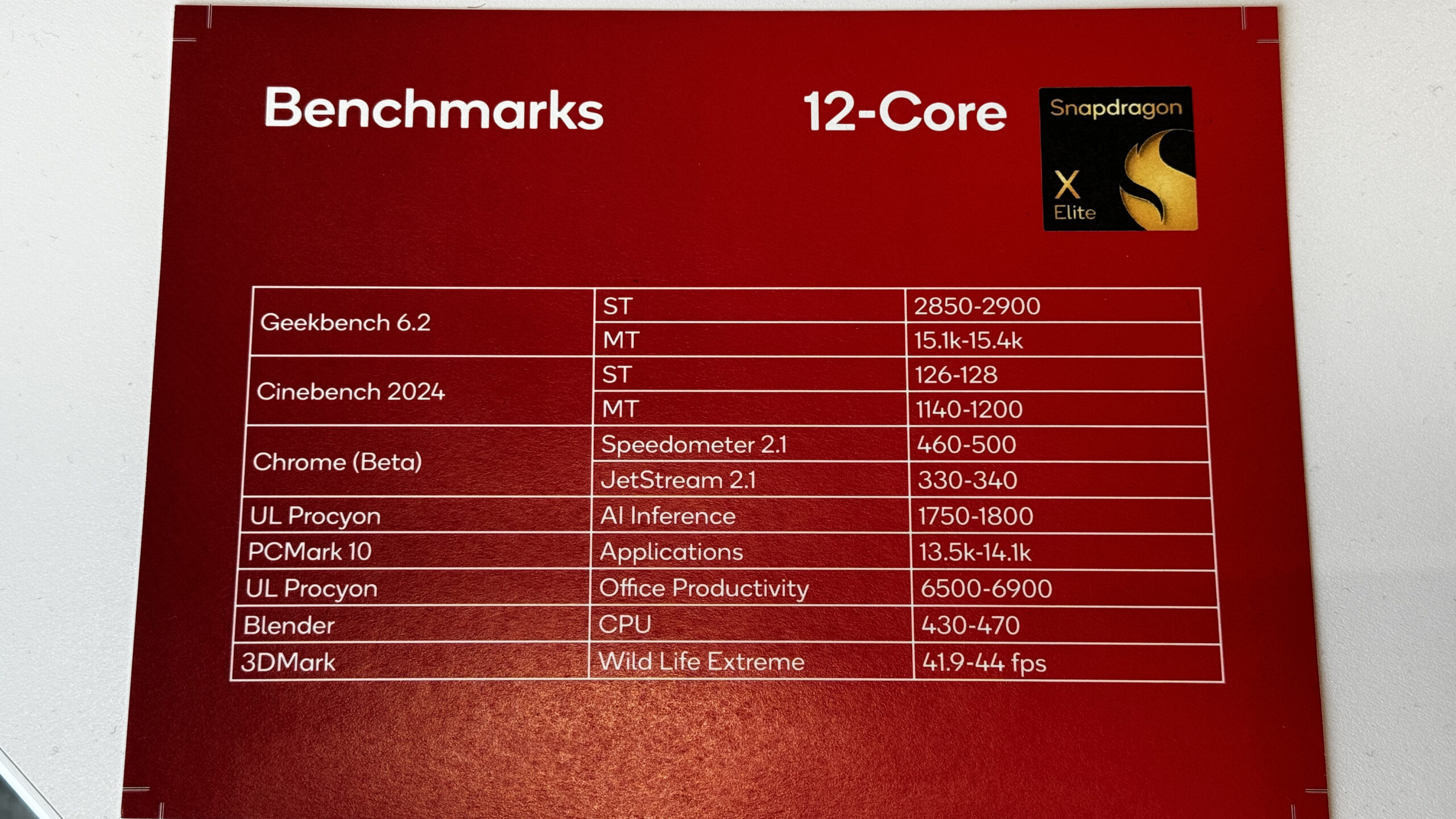The Snapdragon X Elite is Real
- Paul Thurrott
- Apr 05, 2024
-
54
I want to believe. But now I have the hands-on experience I need to cast aside (most of) the doubt: The Qualcomm Snapdragon X Elite is the real deal, an Arm-based chipset for PCs that achieves what many thought impossible. It doesn’t just rival the best that the PC world has to offer, it surpasses the most recent Intel and AMD chipsets across CPU, GPU, and NPU. It also bests Apple’s latest mainstream Mac chipset, the Apple Silicon M3. It often does so by a wide margin.
I know. You’re waiting for the asterisk, the qualifying “but” that starts the second half of the sentence. So let me get that out of the way first. After over seven years of disappointment and broken promises, 12 years if you count Windows RT, it’s important to have all the information and not get caught up, yet again, in a level of hype and excitement that far surpasses reality.
Windows Intelligence In Your Inbox
Sign up for our new free newsletter to get three time-saving tips each Friday — and get free copies of Paul Thurrott's Windows 11 and Windows 10 Field Guides (normally $9.99) as a special welcome gift!
"*" indicates required fields
When one says that the X Elite chipsets—more on that “s” in a bit—“surpass,” “best,” or “beat” other chipsets, whether they’re x64 designs from Intel or AMD or Arm-based designs from Apple, what they’re referring to is benchmarks. Benchmarks that measure such things as performance and efficiency across the CPU, GPU, and NPU that’s present in each of these SoCs (systems on a chip). I’m not a fan of benchmarks, never have been, and I specifically do not benchmark the hardware that I review, preferring instead to report on my real-world experiences in using these devices.
I can’t do that—yet—for the X Elite as there are no computers available to me or other reviewers—yet—that feature these chipsets. There will be soon: Qualcomm has been promising new PCs from a variety of PC makers by mid-2024 since last October, and that message was repeated at a meeting I and several other reviewers had with the company in New York this past week. In lieu of those coming experiences, we’ve had to rely on what Qualcomm claims—which, yes, we should treat skeptically—and, more recently, on leaked benchmark tests. Both have been so exuberantly positive, and such a sharp contrast with our previous Windows on Arm experiences as to be suspicious.

I feel an acute weight of responsibility. It has been clear to me for years that Arm, or an Arm-like SoC architecture, is the future of PCs for the same reasons that it’s already taken over the rest of the world. But it is equally clear to me that Windows on Arm has consistently failed to deliver on the promises. And that these failures, as is so often the case, can be tied to a combination of issues, and not any one thing. Not helping matters, Apple embarrassed the PC world yet again when it announced and then methodically delivered on its own seamless and successful transition to Arm with the Mac and Apple Silicon.
But this isn’t about me not wanting to look foolish. It’s about Microsoft and its ecosystem partners giving Windows another 10 years of runway, if you will, the difference between an inertia-based future in which Windows continues to decline and a healthier path by which Windows remains viable for desktop, productivity-based uses cases. This is a potential extinction moment for the platform I happen to care about the most and continue to bet my career on.
Without getting into the history, which is both convoluted and lengthy, let’s just say that, sitting here in early 2024, the final missing piece of the puzzle for Windows on Arm is the silicon. Qualcomm’s PC-focused chipsets, to date, have under-performed. So, again, we are understandably suspicious that they have suddenly turned it around.
But let’s also acknowledge that the turnaround—and it very much appears to be a turnaround—is not really all that sudden. After working for several years to adapt its smartphone-based chipsets for the PC and running into nothing but performance roadblocks, Qualcomm finally threw in the towel in early 2021 and acquired Nuvia, a company that—like Apple with its M-series chipsets—took the Arm architecture and heavily adapted it to make it make sense on a PC. That involves creating a more efficient and performant way of emulating x64 software code than is possible on traditional Arm chipsets, and it is perhaps notable that Nuvia had been founded two years earlier by two former Apple Silicon chipset designers. Anyway, this turnaround has been three years in the making. Or five, if you date it back to Nuvia’s origins. There’s nothing sudden about it.
We’re still a few months away from real, shipping hardware from major PC makers like Lenovo, HP, and Dell, and Microsoft, which is expected to unveil new Snapdragon-based Surface PCs as soon as mid-May. (Surface Laptop and Surface Pro 10, reportedly.) But we’re also months removed from the October X Elite announcement. And in the interim, we experienced a growing crescendo of leaks, along with a few hints from Qualcomm, that this chipset is the real deal. That it matches or exceeds the performance and efficiency of its mainstream, modern competition.

It is perhaps not coincidental that Apple announced its newest-generation M3 chipsets just days after Qualcomm’s Snapdragon X Elite reveal. Most Apple fans will chafe at the notion that their favorite company, so far ahead of its rivals in the PC space when it comes to that magical combination of performance and battery life, would feel any pressure from Qualcomm, especially in the PC space. But the timing is nonetheless interesting, and it certainly had an impact in our small corner of the world. Here was Qualcomm, favorably comparing its latest Arm chipset for PCs to what was now the previous-generation M2 chipset. But Apple had once again leaped forward and put Qualcomm and the PC industry in the rearview mirror. We had a good six-day run.
But that’s not the full story. Now, Qualcomm is sharing benchmark comparisons between the X Elite and Apple Silicon M3. And sorry, Apple fans, but the X Elite isn’t just competitive, it comes out ahead in some key benchmarks too. To be clear, this is the “base” M3, the chip that’s in my MacBook Air, and not the M3 Pro or M3 Max that powers Apple’s most expensive Macs. But the X Elite specifically targets the same mainstream sweet spot of the market that Apple targets with its MacBook Air. So this comparison is valid, or apples to Apple, if you will.
And Qualcomm has finally allowed reporters, bloggers, and reviewers like myself to put our grubby hands on their reference design laptops, to run benchmarks on our own without any intervention or interference. They showed us a coming generation of apps that are being customized for the unique strengths of the X Elite, in particular its best-in-class NPU. And as important, it showed off several PC games, all running in emulation without any hitches or other issues.
I learned more than I expected during this post-meeting, hour-long hands-on experience. Including, go figure, that there are at least two different “versions” of the X Elite chipset, running at different base clock speeds. (I saw three; others reported two.) It’s not clear how or if Qualcomm will market these, indeed they were reluctant to discuss it, noting only that it would not imitate a “certain company” by confusing the market with multiple SKUs (product editions). Knowing the PC market as well as I do, I suspect there was some call for some variety, however. So we’ll see how that turns out.


Here’s what I can tell you for now, based on quick examinations of Task Manager and System settings across multiple Qualcomm reference PCs. There’s a Snapdragon X Elite X1E84100 with a base clock speed of 3.8 GHz and versions at 4.0 GHz and 4.2 GHz at the least. Each features the same NPU with the same market-leading 45 TOPS of AI accelerated performance (and, I’m guessing, the same GPU, but that I can’t state certainly). The PCs I used were configured with 16, 32, or 64 GB of RAM, and it’s fast LPDDRx5 RAM.

When Microsoft first announced Windows 10 on Arm with Qualcomm back in late 2016, the combination was marketed as the Always Connected PC, and the advantage of this platform were threefold: Efficiency, battery life, and 5G connectivity (hence, the brand name). In other words, it was a new push to bring the best of mobile—smartphone and tablet, but mostly smartphone—to the legacy PC platform. That was always real, but we’re all familiar with the resulting performance issues and Qualcomm’s inability to deliver on its “Core i5-level performance” promises.
With the X Elite and this new generation of Arm PCs, Qualcomm appears to have blown by the performance concerns. And it, with Microsoft, is expanding the advantages of this platform to include local AI capabilities. Here, the concerns are all upended. On the one hand, Qualcomm is in a leadership position with its NPU, exceeding even the performance of Apple’s Neural Engine. And it is Microsoft and the software ecosystem that are bringing up the rear, with precious little to show when asked why anyone would even need such a thing in a PC. There’s no software.
There will be. And you’ve already seen what is arguably the most important single app cross the Arm finish line: Google announced the stable release of an Arm-native version of its dominant Chrome web browser two weeks ago, a stunning level of support from a company that has done absolutely nothing to help Windows, ever, in supporting a platform that today has a user base of roughly zero. Google, inexplicably, has formally acknowledged Windows on Arm as a viable, important platform. And Chrome running on Windows on Arm is even better, in some ways, than it is on today’s PCs: It’s 20 percent faster than Chrome for x64 in the Speedometer 2.1 benchmark. (Yes, Speedometer 3.0 was just released. We should have numbers for that soon as well.)
It’s not just Chrome. Microsoft Edge is 57 percent faster on Arm, and Brave is 15 percent faster. From an app launch latency perspective, we’re seeing other Arm advantages, too. Microsoft Teams is 38 percent faster, Mozilla Firefox is 62 percent faster. Steam is 39 percent faster. Spotify is 69 percent faster. And Adobe Photoshop is 7 percent faster. Running natively on Arm matters.
But so, too, does x64 emulation, since most software is not yet tailored for Arm, a process that could involve various levels of work on the part of developers. (You may recall that Microsoft offers an Arm64EC framework that lets developers upgrade parts of existing apps to Arm in addition to the usual porting/recompiling capabilities.) And we saw evidence that both scenarios are experiencing a renaissance of sorts.
On the emulation front, Qualcomm let us play three x64 games—all desktop apps acquired from the Epic Games Store—on their references PCs using an Xbox wireless controller: Baldur’s Gate, Control, and Redout. I stuck largely to the latter, a racing game, and experienced smooth, glitch-free performance with a consistent 35 to 40 FPS at 1080p. I hear you, gamers are looking for 60 FPS. But this isn’t a gaming rig, it’s a reference laptop using a chipset that’s aimed at Ultrabooks, running games in emulation. That’s impressive. And I watched others play Baldur’s Gate and Control with similar glitch-free performance, and was similarly impressed.

If you’re looking for native apps, they’re coming, as are native apps in which core workloads are being optimized specifically or the X Elite and its powerful NPU. It’s not clear to me which of these apps are using Arm64EC, not that it matters. But companies like Adobe, Microsoft, Netflix, Spotify, and many others have updated for Arm or are doing so.
As important, they’re also being updated for the X Elite NPU specifically. And these hands-on demos were particularly notable, and hint at the solution to that gaping hole in the AI story for Windows: So-called AI PCs are all well and good, but when are we going to see a killer app that will trigger a wave of PC upgrades? Is there some app that will do for the NPU what Chrome will do for Arm?

That depends on your needs. But the demos that Qualcomm let us experience showed off will be compelling to content creators of all kinds. OBS Studio, which I use regularly for screen recordings, is getting several NPU upgrades to core components this year, starting with one that can display captions with real-time language translations as you speak. The DaVinci Resolve video editor is using the X Elite NPU to track a person or other object in video, also in real-time. And Audacity is using the NPU to create music of any kind, with or without lyrics, using a text prompt. I experienced each of these advances personally and was blown away in each case.
Looking ahead, one can reasonably expect Microsoft to use Build 2024 in May to announce that key AI experiences—new and existing—in Windows and its in-box apps will be updated to use the NPU when it makes sense. And that Copilot, broadly—in Windows, on the web, in Microsoft 365, and elsewhere—will move to a hybrid model that takes advantage of local AI acceleration when possible, offloading to the cloud otherwise. I suspect there will be third-party announcements then as well. But whatever these announcements involve, this is the year that the ecosystem makes its push for local AI. And Qualcomm, with the best NPU by far, is poised to capitalize on that.

Circling back to the core value proposition here, Windows on Arm will make sense when we achieve full compatibility via a combination of native apps and emulation that’s so good you don’t even know it’s happening. It will make sense when the performance of those apps is so good you don’t have to think or worry about it. It will make sense when the average battery life of PCs rises from today’s dismal 5 to 6 hours to something well north of 10 hours, hopefully 15 hours. It will make sense when PC makers can finally build compromise-free laptops without any fans or noise that can take on the MacBook Air head-to-head.
Based on all the evidence, most especially my recent hands-on time with Snapdragon X Elite reference design laptops, it’s now clear that this era, long derided as a fantasy, is upon us. It’s happening.
Yes, we still have more to learn, and real-world experience with real, shipping PC laptops will tell the full tale. But exuberance about the Snapdragon X Elite no longer feels irrational. Indeed, it feels quite rational: This chipset and its successors have given Microsoft the runway it needs to drive Windows forward for the next decade. I hate to declare “mission accomplished,” as we all know how that can work out. But I feel good.
Really good.